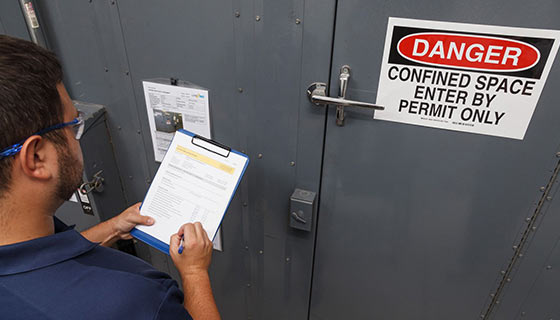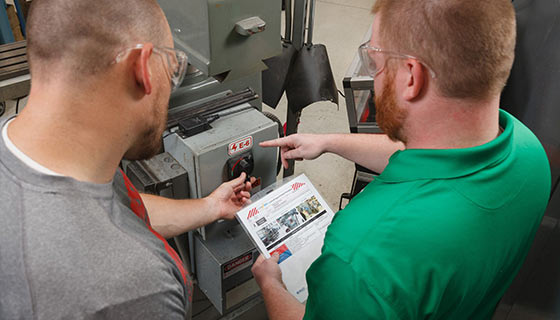Labels for Safety, Visuals and Facility ID Desktop Printers
Labels for Product, Wire and Lab ID Benchtop Printers
Labels for Safety, Visuals and Facility ID Desktop Printers
Labels for Product, Wire and Lab ID Benchtop Printers
Safety and Facility ID Desktop Printers
Product, Wire and Lab ID Benchtop Printers
Barcode Scanners and RFID Readers
PaintStripe Floor Marking Stencils
Valve Lockouts & Hose Lockouts
Group Lock Boxes & Permit Control
Pipe Marker Accessories & Mounting Brackets
Maintenance and Production Tags
Calculators and Assessment Tools
Product Finders and Data Sheets
Workplace injuries. Illnesses. Deaths. Safety education can help to prevent all of them. But while the physical and emotional advantages of a safety program are clear, the financial benefits can be just as impactful on employees and companies. Never underestimate the impact that safety training can have on your company’s profitability and efficiency: taking a proactive step to implement safety practices within your organization is essential to avoiding costly on-the-job injuries and illnesses.
The Bureau of Labor Statistics’s (BLS) Survey of Occupational Injuries and Illnesses (SOII) shows that private industry employers reported 2.8 million nonfatal workplace injuries and illnesses in 2019 alone. These numbers are largely unchanged from the BLS’s 2018 survey.
Workplace injuries and illnesses can slow down production times, increase absenteeism, and even contribute to lowered employee morale — all of which run up company costs.

The National Safety Council (NSC) estimates that the costs for an on-the-job injury are $1,100 per worker, $42,000 per medically consulted worker and $1,220,000 per death — numbers that are far greater than what workers’ compensation alone can cover.
The direct, or hard, costs of workplace injuries and illnesses include, but are not limited to:
Medical expenses include everything from emergency services to surgical operations to rehabilitation.
The legal costs associated with workplace incidents include both insurance premiums and attorney fees.
If a work accident turned into a serious injury or death, OSHA will investigate and the company may incur a fine or penalty.
Sick pay will always be an indirect cost of a workplace injury or illness.
The indirect, or soft, costs of workplace injuries and illnesses include, but are not limited to:
Administrative expenses include everything from investigating the incident to factoring in the production loss. More injuries mean more internal investigations into what occurred, as well as increased absenteeism.
If workers are on workers’ compensation, new workers will have to be hired, trained and compensated.
Any property or equipment that was damaged will need to be repaired or replaced to fully resume production.
A bad accident can also mean a loss of reputation—and a poor reputation leads to a loss of revenue and difficulty attracting skilled workers.

The cost savings of safety training can be seen in a multitude of areas, ranging from a reduction in medical expenses and administrative expenses to insurance premiums and OSHA fines. But a safety training program does more than just save a company money. Safety training not only lessens the costs of workplace illness and injury, but also provides a significant return on investment.
Changes made to the workplace that improve safety and health can strengthen overall productivity and financial performance.
Some of the benefits of safety training include:
Safety programs should not be looked at as an expense, but rather as an investment. The money spent on preventing injuries or illnesses is likely to be far less than what would be spent if those programs didn't exist and accidents prevailed. Injuries and illnesses are often preventable, so prioritizing a safety program as a core business strategy is essential.
Communication and accurate labeling are among some of the most important aspects of many business operations. Poor communication, on one hand, can lead to distrust and confusion in the workplace, which ultimately may result in high turnover rates and avoidable costs.
A mislabeled product, on the other hand, could mean consumers are not getting what they think they are getting, potentially putting them at risk. Selling a product with false advertising could lead to serious legal consequences and high costs to the company. A mislabeled product could also have very dire consequences internally. Hazardous materials that are mislabeled, or unlabeled, could seriously injure or even kill employees.
Teaching employees how to effectively communicate and properly label can save your company a lot of money in the long run, especially when it comes to labeling hazardous materials, electrical wiring and cables or pipes and valves. It can also prevent you from ruining your reputation or losing employees.
Safety training keeps production running by decreasing absenteeism and illness among employees. Slow-downs or stops to production have tremendous repercussions, especially when they are ongoing or frequent. Repercussions may include higher costs, weakened productivity and lowered retention rates.

Safety training aimed at maintaining production could benefit from hazard analyses; that is, reviewing records of incidents, or almost incidents, understanding what problems are most common and figuring out what kind of safety services can eliminate them. The analysis could include removing certain types of hazards, such as those associated with slips, trips or falls, electrical wiring or health matters (i.e., limiting the amount of time workers can spend in a noisy area). In terms of health safety, it could also include providing hearing protection or installing more handwashing stations.
A hazard analysis could also result in additional safety procedures and protocols. A lockout tagout program, for example, helps educate employees on the procedures they need to know when performing maintenance on a piece of equipment. Confined spaces protocol, for another example, helps ensure that employees return home safe regardless of their work location.
Safety training gets employees engaged—and engaged employees create safer work environments. For one, it strengthens communication not only in individual departments, but also between workers and upper management. With more of an incentive to discuss workplace hazards, employees may feel more empowered to point out safety concerns to their superiors.
In the long run, this kind of empowerment builds a safer work environment, all the while fostering retention and saving money.
Finally, having a safe work environment can be a big advantage to companies in terms of hiring, recruiting and retaining employees, as well as attracting and maintaining customers. Businesses with established health and safety protocols can impact and attract customers and employees alike that prioritize safety in the workplace.
A highly-skilled potential employee that is trying to decide between your company and another may simply decide that a workplace with more safety protocols is the better option. This may especially be the case for workers with families, who are older or who have health concerns. The last thing you want to do is lose an impressive new hire over a poor labeling system or a lack of conduct protocols.